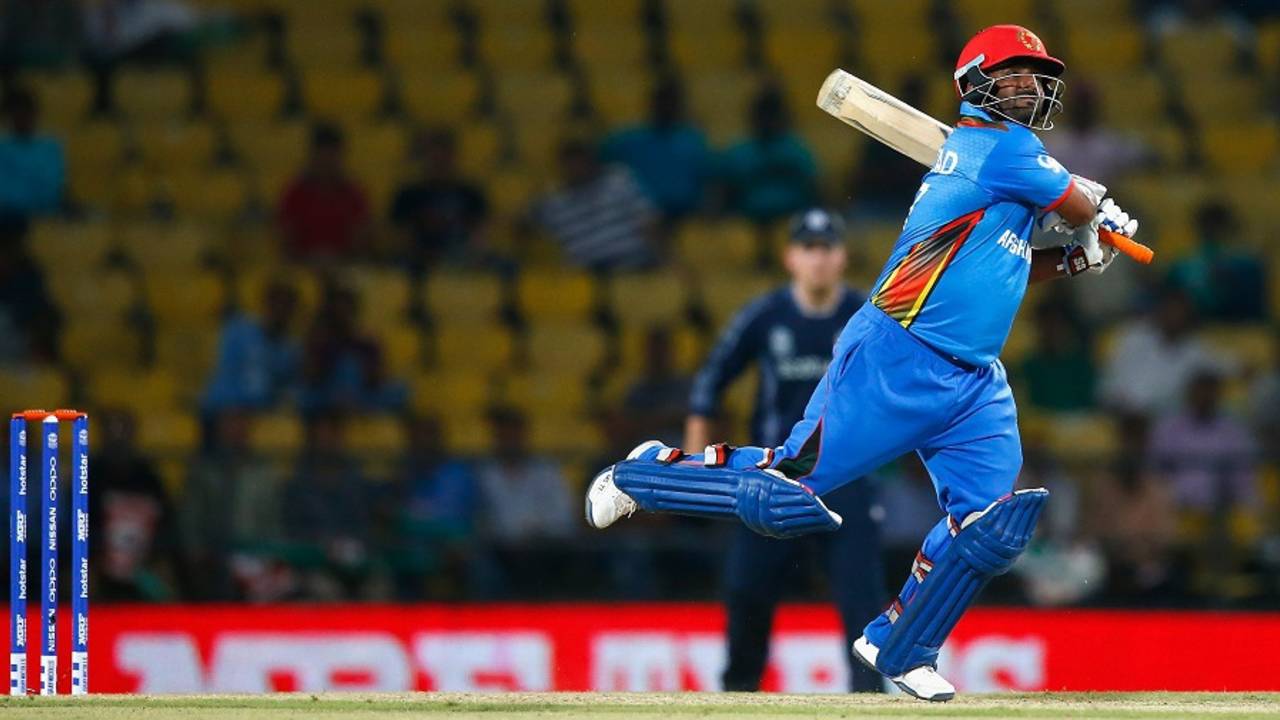The uniqueness of Mohammad Shahzad
There is a method to the Afghanistan opening batsman's madness. And somehow with all the swinging, hoicking, slapping and missing, he does make real runs
Jarrod Kimber in Nagpur
10-Mar-2016
It's not in the coaching manual, but Mohammad Shahzad doesn't care • International Cricket Council
Mohammad Shahzad is facing completely the wrong direction, later he's on one leg, at another time he's slicing the ball like a roadside salami salesman. If someone showed Shahzad the textbook, he'd lean back and hoick it as hard as he could.
Sometimes for six, sometimes straight up in the air.
For the 2015 World Cup there was a Shahzad shaped hole in Afghanistan's team. And it is a sizable hole. Shahzad is more large Big Mac meal than the kale and quinoa salads of most pro cricketers. That was ultimately the reason he didn't make that tournament. But in his case, size doesn't matter.
Of course he bends over to take deep strained breaths 15 balls into his innings. Of course he doesn't find as many singles as other batsmen. And of course he can't whip around to stop a leg bye being taken. But he can keep, and he can hit.
In his mind, he is trying to emulate his idol MS Dhoni but, like some of the most interesting musicians in history, while he is just trying to copy his hero, what he makes is wonderful and original. Dhoni might be the king of the helicopter shot, but Shahzad is the one true master of the agricultural afghan drunken samurai method.
It's not pretty, or classical, or even approaching stylish. It's a spit in dirt, your uncle after one too many, a beer belly on a male model. Shahzad hitting through the covers is about as ugly as cricket gets. It's a cross-bat cover-sweep slog-slap. When it goes wrong it either gets bunted into the ground like a disgusting mistake, or flies up in the air to be caught. When he gets it right it just flies, it feels like he has hit it so far the fielders are diving for safety, not to stop the ball.
He doesn't just hit - although he does just hit - he actually puts together innings. There is a method, although not one he would share or teach to anyone, to his madness. His method, obviously, but somehow with all the swinging, hoicking, slapping and missing, he does make real runs. This is a man who made an unbeaten 215 in a chase of 494 against Canada. A man with the sixth-highest score in T20Is. A man who once beat Zimbabwe all but on his own in an ODI. And who is currently ranked 12th in the world in ICC rankings for T20s.
He doesn't make sense; he doesn't have too.
There is not a moment he is not entertaining. He laughs, gets angry, pulls faces, hits redonkulous shots, makes jokes with the press, and translates his own press conference answers into English. At one stage in this match Ian Gould, the umpire, just flicked his helmet like he was a cheeky school boy. He lives his life with his heart, and pretty much every other single organ he has, on his sleeve.
If you can tell something deeply personal about someone from the way he bats, Shahzad lives a life worth living.
People tend to focus on the boundaries of a batsman, but for Shahzad the plays and misses, the mishits and the stupid batting choices are just as exciting. When he gets out it looks terrible, but then again, so do some of his best shots.
Against Scotland he played a back-foot inside-out drive to a ball angled in that even if he middled it would have been the worst shot played by another player that day. Instead he hit it straight up in the air, and confirmed it as one of the worst shots of the day, beating some of his previous boundaries. Against Hong Kong it was the run-down-the-wicket swipe to the leg side that gets caught on the off side. But it also wasn't any uglier than the six he donkey-hurled over wide mid-on earlier.
This is not an international batsman; this is a cartoon character in human form.
When he was out, he just shrugged and walked off. There was no disappointment, he'd done well. He was happy with his lot in life, and this game. He was supposed to be upset with giving his wicket away - again. He was supposed to be disappointed that he didn't reach his 50. He was supposed to be frustrated that he didn't see the match through until the end.
Then again, with his technique, he wasn't supposed to make runs in the first place.
Jarrod Kimber is a writer for ESPNcricinfo. @ajarrodkimber
